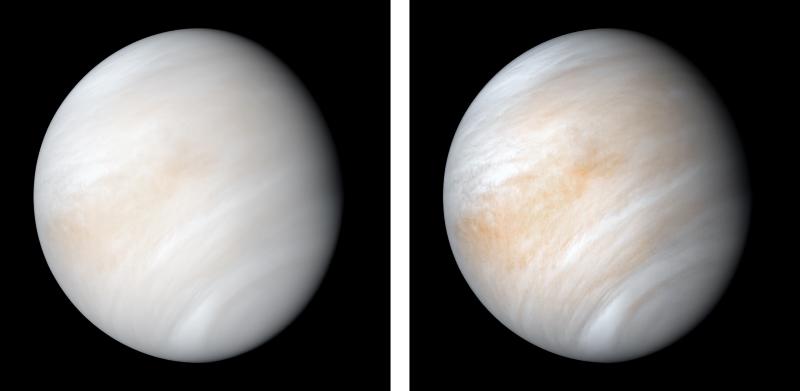A groundbreaking study by a French-Swiss team of researchers calls into question conventional theories about the evolution of rocky planets’ atmospheres

Photos of Venus and its thick atmosphere taken by NASA’s Mariner-10 probe
10 August 2023 — With the exception of the rare and grandiose “Eureka!” science generally advances in baby steps. Even so, these can completely erase what has been taken for granted for decades. This is the case for a French-Swiss study published yesterday in Nature magazine, which, by revising the modeling of the atmospheres of rocky planets when they are rich in water vapor, rewrites two scenarios – the early evolution of Venus and the distant future of the Earth.
To understand the importance of this work, it is necessary to go back to the birth of the Solar System, 4.6 billion years ago. Around the newborn Sun, there is a disk of gas and dust. Through a phenomenon known as “accretion,” these particles stick together, forming small bodies that in turn agglomerate. The atmosphere on these protoplanets is hellish, constantly bombarded by asteroids and heated by the radioactivity of their innards. If we focus on Venus and Earth, twins with almost identical diameters, the temperature is so high that both planets are covered by a global ocean of magma. As a corollary, the water present on the surface is vaporized in a compact atmosphere, and planetologists have long wondered what’s going on in this pressure cooker.
However, as Franck Selsis, director of research at the CNRS’s Bordeaux Astrophysics Laboratory and lead author of the study, points out, “these thick atmospheres are very complicated to model because at the top, we have very short evolution times, on the order of fractions of a second, very different from what we find at the base of the atmosphere.” To get around this difficulty, American James Kasting hypothesized in 1988 that these hot, water-vapor-filled atmospheres are convective. In other words, heat transfer takes place through the movement of air masses, just as it does on our planet today. Such a model “simplifies our lives,” Selsis admitted, “because if we give ourselves a surface temperature, we can build an atmosphere from top to bottom with a gradient. For example, on Earth, the temperature drops by 6.5°C when you go up a kilometer.”
For a long time, a 3D simulation was impossible
Add to this the fact that water vapor is a greenhouse gas, and we have a scenario for Venus in its youth, where the surface temperature remained excessive and the surface was molten for hundreds of millions of years. Farther from the Sun, the Earth’s temperature fell below a certain threshold. The water trapped in the atmosphere then condensed, creating a deluge, and forming oceans on a hardened crust. But this solid surface would only be transitory. In a billion years’ time, the output of solar energy will have progressively increased by 10% compared to today, and the oceans will vaporize. Kasting’s model then predicts a galloping greenhouse effect that would generate temperatures where an ocean of lava would once again cover the Earth.
This scenario is not likely, according to the study by Nature, which is based on a refined model and 3D simulation previously impossible to carry out. In reality, a water vapor atmosphere is so thick that solar radiation cannot reach the surface and supply the energy needed for convection. “What’s more,” Selsis added, “such an atmosphere efficiently loses its energy through radiation. It will therefore come out of its runaway phase long before it reaches a temperature at which rocks can melt. To achieve this, it would actually require eight times more energy than the Sun provides.” So it is also necessary to rewrite the early days of Venus, whose lava ocean probably only lived for a few million years. The three future space missions (two by NASA and one by the European Space Agency) to observe Venus up close will be able to detect clues confirming this new hypothesis.
Challenging a model that has been in place for 35 years, the French-Swiss study was subjected to thorough peer review, especially as it also has repercussions for the study of exoplanets with water vapor-laden atmospheres. “We had four reviewers, two of whom had worked extensively on the basis of convective atmospheres,” Selsis noted. “Of course, they made us do a lot of tests. But in the end, given the important consequences of our work in various fields, they recommended that it should be published in Nature itself,” and not in one of its lower-impact “daughter journals,” such as Nature Geoscience or Nature Astronomy.